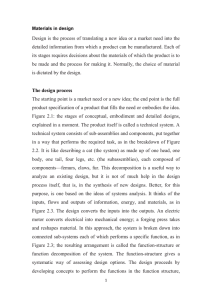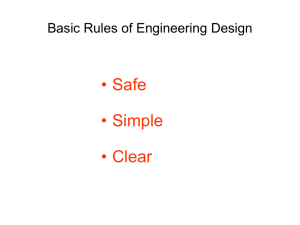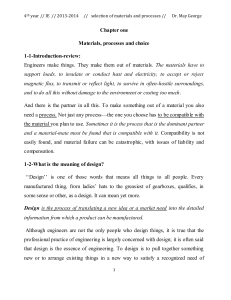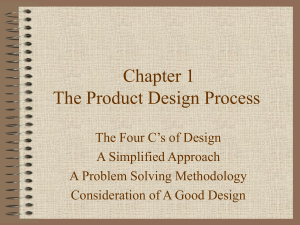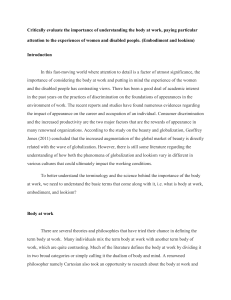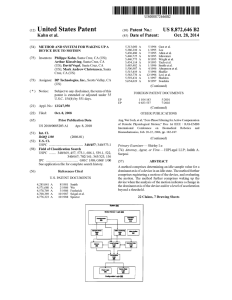Materials in design
advertisement
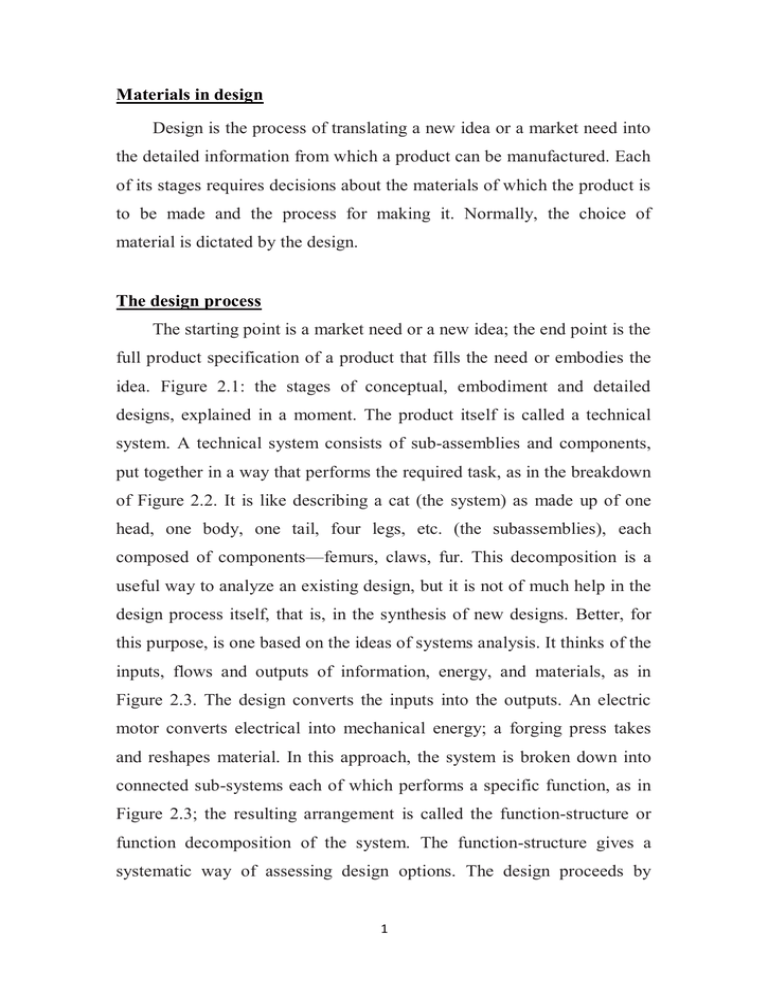
Materials in design Design is the process of translating a new idea or a market need into the detailed information from which a product can be manufactured. Each of its stages requires decisions about the materials of which the product is to be made and the process for making it. Normally, the choice of material is dictated by the design. The design process The starting point is a market need or a new idea; the end point is the full product specification of a product that fills the need or embodies the idea. Figure 2.1: the stages of conceptual, embodiment and detailed designs, explained in a moment. The product itself is called a technical system. A technical system consists of sub-assemblies and components, put together in a way that performs the required task, as in the breakdown of Figure 2.2. It is like describing a cat (the system) as made up of one head, one body, one tail, four legs, etc. (the subassemblies), each composed of components—femurs, claws, fur. This decomposition is a useful way to analyze an existing design, but it is not of much help in the design process itself, that is, in the synthesis of new designs. Better, for this purpose, is one based on the ideas of systems analysis. It thinks of the inputs, flows and outputs of information, energy, and materials, as in Figure 2.3. The design converts the inputs into the outputs. An electric motor converts electrical into mechanical energy; a forging press takes and reshapes material. In this approach, the system is broken down into connected sub-systems each of which performs a specific function, as in Figure 2.3; the resulting arrangement is called the function-structure or function decomposition of the system. The function-structure gives a systematic way of assessing design options. The design proceeds by 1 developing concepts to perform the functions in the function structure, each based on a working principle. At this, the conceptual design stage, all options are open: the designer considers alternative concepts and the ways in which these might be separated or combined. The next stage, embodiment, takes the promising concepts and seeks to analyze their operation at an approximate level. This involves sizing the components, and selecting materials that will perform properly in the ranges of stress, temperature, and environment suggested by the design requirements, examining the implications for performance and cost. The embodiment stage ends with a feasible layout, which is then passed to the detailed design stage. Types of design 1- Adaptive or developmental design takes an existing concept and seeks an incremental advance in performance through a refinement of the working principle. This, too, is often made possible by developments in materials: polymers replacing metals in household appliances; carbon fiber replacing wood in sports goods. The appliance and the sports-goods market are both large and competitive. Markets here have frequently been won (and lost) by the way in which the manufacturer has adapted the product by exploiting new materials. 2- Variant design involves a change of scale or dimension or detailing without change of function or the method of achieving it: the scaling up of boilers, or of pressure vessels, or of turbines, for instance. Change of scale or circumstances of use may require change of material: small boats are made of fiberglass, large ships are made of steel; small boilers are made of copper, large ones of steel; 2 3 Design tools and materials data design tools are shown as inputs, attached to the left of the main backbone of the design methodology in Figure 2.5. The tools enable the modeling and optimization of a design, easing the routine aspects of each phase. Function-modelers suggest viable function structures. Configuration optimizers suggest or refine shapes. Materials selection enters each stage of the design. The nature of the data needed in the early stages differs greatly in its level of precision and breadth from that needed later on (Figure 2.5, right-hand side). At the concept-stage, the designer requires approximate property-values, but for the widest possible range of materials. All options are open: a polymer may be the best choice for one concept, a metal for another, even though the function is the same. The problem, at this stage, is not precision and detail; it is breadth and speed of access: how can the vast range of data be presented to give the designer the greatest freedom in considering alternatives? At the embodiment stage the landscape has narrowed. Here 4 we need data for a subset of materials, but at a higher level of precision and detail. These are found in the more specialized handbooks and software that deal with a single class or sub-class of materials—metals, or just aluminum alloys, for instance. The final stage of detailed design requires a still higher level of precision and detail, but for only one or a very few materials. Such information is best found in the data-sheets issued by the material producers themselves, and in detailed databases for restricted material classes. A given material (polyethylene, for instance) has a range of properties that derive from differences in the ways different producers make it. At the detailed design stage, a supplier must be identified, and the properties of his product used in the design calculations; that from another supplier may have slightly different properties. 5 6
